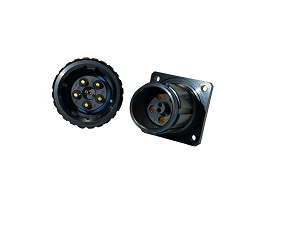
As the defence and aerospace industries increasingly use hybrid and electric engines for ground vehicles and aircraft, they are demanding three-phase power or redundancy lines to serve as a reliable backup.
To rise to this challenge, Smiths Interconnect has launched its five-pole HBB series, featuring all the benefits of the hyperboloid contacts and the quick-latch mechanism. Gregory Kay, global product line manager at Smiths Interconnect explains why this new range was developed and what it means for the defence industry.
“The five-pole is an expansion on the existing HBB platform,” Kay explains. “The new configuration consists of the existing size 21 shell but contains five poles, each with size eight contacts as well as two interlock pins.”
This means that in a very tight space, the customer can run five power lines which increases the connectors’ flexibility and offers the ability to run redundant lines as required.

When compared to traditional 38999 screw thread connectors, the HBB series offers a number of additional benefits:
One of the primary value-added benefits of the HBB series is that its contacts feature the Hypertac Hyperboloid technology. The Hyperboloid contacts have low insertion and extraction forces and are easy to mate and demate. In addition, the Hyperboloid contact provides very low contact resistance, minimising temperature rise with power. By combining the HBB’s unique shell design together with the Hyperboloid contact, Smiths Interconnect is able to provide exceptional vibration and shock immunity in this remarkably rugged series.
An added benefit of the new five-pole version is that it has even higher safety protection than the single pole. These connectors also feature interlock pins, which are last-mate first-break, so the last thing that connects during mating is the first thing that breaks when it gets disconnected. By utilising this interlock feature, customers are able to ensure the utmost safety for their operators.
A quick latch mechanism is comprised in the whole HBB series with a spring-loaded collar which can be unmated through a light turn. When the connector is mated, the locking ring moves and latches itself, providing haptic and visual feedback to confirm that it is latched. Compared to a 38999, the likelihood of not fully mating the connector is drastically reduced. This system makes it physically easier to latch the connector by the operator, making it possible to place them much closer together on a panel.
As the five-pole is able to handle five different lines, it is ideal for combat vehicles both ground and air as it can carry power to various different areas on the vehicle. Looking forward, connectors with these capabilities will be increasingly in demand.
“We’re starting to see more hybrid fighting vehicles, and soon we will see all-electric,” Kay explains. “These connectors will be needed for all the ancillary equipment as well as the drive train itself.”
The HBB five-pole is also ideal in wider applications within defence, such as missile launcher platforms and ground radar installations, where the requirements for robust high-power interconnectivity are ever-growing.
For more information about the features and benefits of the five-pole HBB connectors, download the brochure below.


